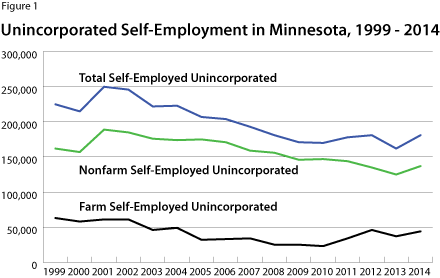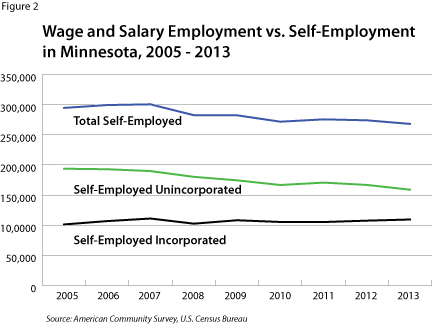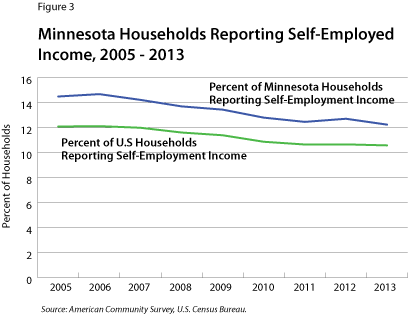
By Dave Senf
March 2015
The freelance worker revolution might be under way, but you can't prove it by the data.
The Johansen-Dahl family lives just south of Taylors Falls. The family consists of parents Mike and Mary and two 20-something daughters, Ashley and Brittany. The family runs a small apple orchard that is open for "U-pick 'em" on weekends in August, September, and October. All of the family pitches in with orchard chores, especially during the fall. The orchard is legally organized as an unincorporated partnership, with all four family members listed as partners.
Mike is also a partner in a two-attorney firm that is registered as an unincorporated limited liability partnership, and he serves on the local county board. Mary is an accountant at an incorporated CPA partnership. She is also head volleyball coach at the local high school for four months during the fall and coaches club volleyball during the other eight months.
Ashley delivers newspapers in the morning and has started going to Elance-oDesk to bid on web design projects, having just completed a web designing degree. Last month she won two jobs.
Brittany is a restaurant hostess in Stillwater and is the music director at the family's church.
If one counts carefully, each member of this fictional family has three jobs, except for Mary, who has four jobs, bringing the total for the entire family to 13. Or is it five jobs, four side businesses and four hobbies? Or is it some other combination?
The family's work schedule might seem extreme, but their busy workdays aren't much different from what some media are reporting about the growing number of freelancers, consultants, independent contractors, sole proprietors and self-employed. The emerging independent workforce is being referred to as the 1099 economy (or the sharing economy, gig economy, freelance economy or flex economy.)
According to media reports, these independent workers are showing up everywhere — everywhere, that is, except in employment statistics compiled by DEED. Does that mean DEED's employment numbers are missing the shift to 1099 economy jobs or are the reports of the 1099 economy shift overstated? This story examines those questions.
Estimates of the size of the 1099 economy are impressive. A survey sponsored by the Freelancers Union and Elance-oDesk last year concluded that 53 million Americans (34 percent of the U.S. workforce) are working in the 1099 economy. Another study by MPO Partners reports a headcount of 17.9 million "solopreneurs" or independent workers who regularly work 15-plus hours a week and an additional 12.1 million independent workers (termed side-giggers) who work fewer than 15 hours a week on a recurring basis.1
Of the three employment series published by DEED, two aren't designed to capture 1099 jobs. Both the Current Employment Statistics (CES) and Quarterly Census of Employment and Wages (QCEW) series track only wage and salary employment compiled from payroll numbers provided by employers.2
Some 1099 workers, however, are included in wage and salary employment statistics because some freelancers, independent contractors, consultants and other self-employed people incorporate their businesses. They are classified as "incorporated self-employed," giving themselves paychecks that show up in DEED's administrative records and are added into CES/QCEW job numbers.
The other 1099 workers are "unincorporated self-employed" and are not counted in CES/QCEW totals. Most 1099 workers are sole proprietors and receive payments for their work without Social Security, Medicare or income taxes deducted. Instead, 1099 workers report their income for tax purposes using 1099 forms, thus the 1099 label.
DEED's third employment series, Local Area Unemployment Statistics (LAUS), theoretically is designed to capture some 1099 work activity. LAUS is based on household responses to the monthly Current Population Survey (CPS), which is used to estimate the number of people in the labor force, both employed and unemployed.
Roughly 60,000 households nationally, including 1,600 in Minnesota, are asked each month if anyone in the household worked for payment in the previous week. If so, then they are asked "were the individuals employed by government, by a private company, a nonprofit organization or were they self-employed?" If some of the individuals were self-employed, the next question asked is "Are the businesses incorporated?" Respondents who say no are classified as unincorporated self-employed. Otherwise, they are counted as incorporated self-employed and show up in wage and salary employment in LAUS data.3
So if a surge in freelance employment is occurring, then unincorporated self-employed estimates should have climbed over the last few years. But Minnesota's unincorporated self-employed numbers have until last year been on a downward trend (see Figure 1).

Source: Current Population Survey with annual average data available at Bureau of Labor Statistics
According to Current Population Survey (CPS) responses, nonfarm unincorporated self-employed in Minnesota peaked at 189,000 in 2001. The numbers then declined to 125,000 in 2013, before showing some signs of recovering in 2014 at 137,000. As measured by the CPS, 2014 wage and salary employment in the state is up 140,000 from 2009, while non farm unincorporated self-employment has increased 9,000 over the same period.
The American Community Survey (ACS) from the U.S. Census Bureau is another household-based survey that paints a similar picture. Three million households in the U.S. are surveyed once a year, with roughly 70,000 Minnesota households (3 percent of the state's total) participating. The ACS, just like the CPS, asks questions about the employment status of household members. (See the self-employment sidebar for the questions asked.) ACS self-employed estimates, which include both incorporated and unincorporated self-employed, also shows a downward trend (see Figure 2).

Wage and salary employment climbed by 135,000 between 2009 and 2013, while total self-employment has declined by 4,000 workers since 2009. ACS self-employment estimates peaked in 2007 at 301,000, but fell by nearly 11 percent to 268,000 by 2013.
A careful reading of the self-employment sidebar listing the relevant self-employment questions in the two household surveys might help clear up some of the mystery surrounding the direction of Minnesota's 1099 workforce.
If a person worked at more than one job or business, only the place where he or she worked the most hours is counted in the surveys. All of the Johansen-Dahl family members contribute to keeping the apple orchard going, but they all work more hours in other jobs. The apple orchard work, therefore, isn't included in any of DEED's three employment series.
Table 1 tracks how the family's various hypothetical work activities would be counted in DEED's three employment series and two other employment series. The other employment series — the U.S. Census Bureau's Nonemployer Businesses (NB) statistics and Bureau of Economic Analysis' Nonfarm Proprietors (NP) statistics — are included in the table because some of the family's work activities show up in these employment series.4
Both the nonemployer and proprietor statistics are based on tax return information compiled by the Internal Revenue Service. The tax returns are from corporations, partnerships and sole proprietorships that report business income but have no employees. Most 1099 workers fall under the sole proprietorship for income tax purposes.
| Name | LAUS Job Count | CES/QCEW Job Count | BEA Nonfarm Proprietor Job Count (NP) | Census Nonemployer Business Job Count (NB) |
|---|---|---|---|---|
| Unincorporated Self- Employed Job | Wage and Salary Job | |||
| Mike | Attorney Job (1) | County Board (1) | Attorney Job(1)
Apple Orchard Job (1) |
Attorney Job(1)
Apple Orchard Job (1/4) |
| Mary | - | Accountant Job (1)
Head Volleyball Coach Job (1/3) Club Volleyball Job (2/3 ) |
Apple Orchard Job (1) | Apple Orchard Job (1/4) |
| Ashley | Newspaper Delivery Job (1) | - | Newspaper Delivery Job (1)
Apple Orchard Job (1) Web Developer Job (1) |
Newspaper Delivery Job (1)
Apple Orchard Job (1/4) Web Developer Job (1) |
| Brittany | - | Restaurant Hostess Job (1)
Music Director Job(1) |
Apple Orchard Job (1) | Apple Orchard Job (1/4) |
| Total | 2 Jobs | 5 Jobs | 7 Jobs | 5 Jobs |
| Source: Minnesota Department of Employment and Economic Development | ||||
Mike's law firm work is his primary job. The law firm is unincorporated, so Mike shows up as unincorporated self-employed in LAUS. Mary's primary job is her accountant work at her incorporated CPA partnership, so she is counted as having a wage and salary job in LAUS.
Ashley spends the most time delivering newspapers. Up until recently, Ashley mistakenly reported her newspaper delivery job as a wage and salary job because she used to get a paycheck from the newspaper. Two years ago, the newspaper moved delivery workers off their payroll, converting them to independent contractors. Mary now gets a 1099 form instead of a W-2 form at the end of the year. Her independent contractor status makes her unincorporated self-employed in LAUS numbers.
Ashley isn't alone in making this mistake. The Bureau of Labor Statistics estimates that 12 to 15 percent of independent contractors mistakenly consider themselves wage and salary employees. This may account for some of the missing 1099 workers in traditional employment statistics.
Brittany's hostess hours exceed the hours she devotes to the apple orchard or her music directing, so her hostess work is a wage and salary job.
The family would be tallied as having four jobs — two unincorporated self-employed jobs and two wage and salary jobs — in LAUS data.
Mary receives paychecks from her CPA firm, from the high school during the four-month season and from the volleyball club the other eight months. Mary's three jobs are counted as two jobs in CES/QCEW numbers on an annual average basis. Mike receives a small monthly paycheck for his county board work. That is another CES/QCEW job on an annual average basis.
Brittany gets paid weekly at the restaurant and receives a small monthly paycheck from the church for her music director work. Brittany is counted as having two jobs in CES/QCEW annual average data. Ashley doesn't get a paycheck from any of her work activities, so her jobs don't show up in CES/QCEW data. Altogether, the family tallies five CES/QCEW annual average jobs.
Ashley's work activities show up three times in the NP data, as she is a partner in the apple orchard and has set up two sole proprietorships for her newspaper delivery and her web design work. The NP job count assigns each partner in a partnership a job, while only one job per partnership is counted in NB job tallies. The family's work activities show up as seven jobs in Nonfarm Proprietors data and as five jobs in Nonemployer Business statistics.
Users of the various employment series also need to be aware of the annual average factor. LAUS and CES/QCEW jobs are figured on an annual average basis. If a job lasts only six months, it's counted as half a job. A sole proprietorship that lasts six months or only involves six months work each year isn't counted as half a job in NB and NP statistics. Instead the sole proprietorship work shows up as one job in the NB and NP data.
Over the last few years, DEED has devoted research resources to get a better handle on the 1099 economy, primarily to understand the importance of the 1099 workforce in Minnesota's labor market and in the overall economy. DEED has already started to explore NP and NB numbers and other tax data to better understand self-employed and 1099 workers.5
The 1099 economy, however, remains a puzzle, showing up in some data but absent in other data. As shown in Figure 3, the percent of households in Minnesota and nationally that report receiving self-employment income has been slipping since 2006. That seems inconsistent with the assertion by some that the 1099 economy is surging.

Self-EmploymentIn the American Community Survey, the class-of-worker question (included below) categorizes workers based on their relationship to the business where they work. The question identifies self-employed workers and distinguishes between self-employed workers in incorporated and nonincorporated businesses. In cases where a respondent worked at more than one job or business in the last week, the class-of-worker question refers to the job or business for which they worked the most hours. Was this person…
Adapted from Changes in Self-Employment: 2010 to 2011, U.S. Census Bureau, January 2013. |
1Freelancing in America, 2014 State of Independence in America.
2For a more detailed introduction to DEED's three employment series, see "Three's Company", Minnesota Economic Trends, May 2008.
3For a detailed report, see "Self-employment in the United States," Monthly Labor Review, September 2010.
4Nonemployer business statistics are found at U.S. Census. Proprietors employment statistics are at Bureau of Economic Analysis: Regional Economic Accounts.
5See these two DEED articles for more information on the 1099 workforce in Minnesota: "Who's Counting," Minnesota Employment Review, September 2013, and "On Their Own," Minnesota Employment Review, December 2010. Another excellent article on self-employment In Minnesota and surrounding states is "Self-employed: To be, or not to be," Fedgazette, January 2012.